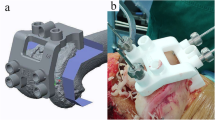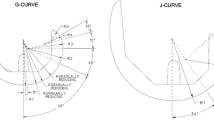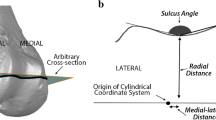Abstract
Purpose
Total knee arthroplasty (TKA) leaves 11–25% of the patients unsatisfied, and patellofemoral joint pain is one cause. This study aimed to compare the differences between kinematics and load transfer in the same knee with axial internal/external rotation of the femoral component (CoRo) versus a separate axial internal/external trochlear groove rotation (TrRo) which is included in the TKA trochlea design.
Methods
A validated weight-bearing finite element model with modifications of the TKA axial femoral component rotation (CoRo) and a modified trochlear rotation (TrRo) was calculated and analysed.
Results
Compared to the neutrally implanted TKA at 105° of flexion, a 6° external rotation of the trochlear groove reduced the retropatellar stress by 7%, whereas a 3° internal trochlear groove rotation increased the retropatellar stress by 7%. With femoral component rotation, the tibia inlay stress of 6.7 MPa at 60° of flexion was two times higher both with a 3° internal component rotation and a 6° external rotation.
Conclusion
These results demonstrate in the tested TKA design that a trochlear groove rotation can reduce retropatellar stress. Additionally, during the TKA operation, the surgeon should be aware of the significant influence of axial femoral component rotation on mechanical inlay stress during flexion and of the fact that even small changes in the patellofemoral joint may influence the tibiofemoral joint. These results support that an external rotation of the femoral component should be preferred in TKA to avoid anterior knee pain. Furthermore, new developed TKA designs should integrate an externally rotated trochlea groove.







Similar content being viewed by others
References
Ahmed AM, Duncan NA (2000) Correlation of patellar tracking pattern with trochlear and retropatellar surface topographies. J Biomech Eng 122:652–660
Akagi M, Matsusue Y, Mata T, Asada Y, Horiguchi M, Iida H et al (1999) Effect of rotational alignment on patellar tracking in total knee arthroplasty. Clin Orthop Relat Res 366:155–163
Anderson JG, Wixson RL, Tsai D, Stulberg SD, Chang RW (1996) Functional outcome and patient satisfaction in total knee patients over the age of 75. J Arthroplasty 11:831–840
Andriacchi TP, Yoder D, Conley A, Rosenberg A, Sum J, Galante JO (1997) Patellofemoral design influences function following total knee arthroplasty. J Arthroplasty 12:243–249
Anouchi YS, Whiteside LA, Kaiser AD, Milliano MT (1993) The effects of axial rotational alignment of the femoral component on knee stability and patellar tracking in total knee arthroplasty demonstrated on autopsy specimens. Clin Orthop Relat Res 287:170–177
Armstrong AD, Brien HJ, Dunning CE, King GJ, Johnson JA, Chess DG (2003) Patellar position after total knee arthroplasty: influence of femoral component malposition. J Arthroplasty 18:458–465
Baldwin MA, Clary C, Maletsky LP, Rullkoetter PJ (2009) Verification of predicted specimen-specific natural and implanted patellofemoral kinematics during simulated deep knee bend. J Biomech 42:2341–2348
Baldwin MA, Clary CW, Fitzpatrick CK, Deacy JS, Maletsky LP, Rullkoetter PJ (2012) Dynamic finite element knee simulation for evaluation of knee replacement mechanics. J Biomech 45:474–483
Barink M, Van de Groes S, Verdonschot N, De Waal Malefijt M (2006) The difference in trochlear orientation between the natural knee and current prosthetic knee designs; towards a truly physiological prosthetic groove orientation. J Biomech 39:1708–1715
Barink M, Van der Mark PC, Fennis WM, Kuijs RH, Kreulen CM, Verdonschot N (2003) A three-dimensional finite element model of the polymerization process in dental restorations. Biomaterials 24:1427–1435
Barrack RL, Schrader T, Bertot AJ, Wolfe MW, Myers L (2001) Component rotation and anterior knee pain after total knee arthroplasty. Clin Orthop Relat Res 392:46–55
Bell SW, Young P, Drury C, Smith J, Anthony I, Jones B et al (2014) Component rotational alignment in unexplained painful primary total knee arthroplasty. Knee 21:272–277
Berger RA, Crossett LS, Jacobs JJ, Rubash HE (1998) Malrotation causing patellofemoral complications after total knee arthroplasty. Clin Orthop Relat Res 356:144–153
Bourne RB, Chesworth BM, Davis AM, Mahomed NN, Charron KD (2010) Patient satisfaction after total knee arthroplasty: who is satisfied and who is not? Clin Orthop Relat Res 468:57–63
Donahue TL, Hull ML, Rashid MM, Jacobs CR (2002) A finite element model of the human knee joint for the study of tibio-femoral contact. J Biomech Eng 124:273–280
Fitzpatrick CK, Baldwin MA, Ali AA, Laz PJ, Rullkoetter PJ (2011) Comparison of patellar bone strain in the natural and implanted knee during simulated deep flexion. J Orthop Res 29:232–239
Fitzpatrick CK, Rullkoetter PJ (2012) Influence of patellofemoral articular geometry and material on mechanics of the unresurfaced patella. J Biomech 45:1909–1915
Fuchs S, Schutte G, Witte H (1999) Effect of knee joint flexion and femur rotation on retropatellar contact of the human knee joint. Biomed Tech (Berl) 44:334–338
Fuchs S, Skwara A, Tibesku CO, Rosenbaum D (2005) Retropatellar contact characteristics before and after total knee arthroplasty. Knee 12:9–12
Ghosh KM, Merican AM, Iranpour F, Deehan DJ, Amis AA (2012) Length-change patterns of the collateral ligaments after total knee arthroplasty. Knee Surg Sports Traumatol Arthrosc 20:1349–1356
Gispert MP, Serro AP, Colaco R, Saramago B (2006) Friction and wear mechanisms in hip prosthesis: comparison of joint materials behaviour in several lubricants. Wear 260:149–158
Godest AC, Beaugonin M, Haug E, Taylor M, Gregson PJ (2002) Simulation of a knee joint replacement during a gait cycle using explicit finite element analysis. J Biomech 35:267–275
Grassi A, Compagnoni R, Ferrua P, Zaffagnini S, Berruto M, Samuelsson K et al (2018) Patellar resurfacing versus patellar retention in primary total knee arthroplasty: a systematic review of overlapping meta-analyses. Knee Surg Sports Traumatol Arthrosc;10.1007/s00167-018-4831-8
Grimberg A, Jansson V, Liebs T, Melsheimer O, Steinbrück A. EPRD Jahresbericht 2016. 2017
Halder A, Kutzner I, Graichen F, Heinlein B, Beier A, Bergmann G (2012) Influence of limb alignment on mediolateral loading in total knee replacement: in vivo measurements in five patients. J Bone Joint Surg Am 94:1023–1029
Halloran JP, Ackermann M, Erdemir A, van den Bogert AJ (2010) Concurrent musculoskeletal dynamics and finite element analysis predicts altered gait patterns to reduce foot tissue loading. J Biomech 43:2810–2815
Halloran JP, Petrella AJ, Rullkoetter PJ (2005) Explicit finite element modeling of total knee replacement mechanics. J Biomech 38:323–331
Hasung K, Jong-Keun S, Jong-Hwan S, Gun-Woo K, Seung-Hyun Y (2016) Total knee arthroplasty with or without patellar resurfacing with grade IV osteoarthritis in patellofemoral joint. Orthopaedic Proc 98-B:154–154
Hauf W, Mittlmeier T, Hagena FW, Plitz W (1992) [Method for in vivo measurement of intraosseous pressure of the patella]. Biomed Tech (Berl) 37:263–272
Heegaard JH, Leyvraz PF, Hovey CB (2001) A computer model to simulate patellar biomechanics following total knee replacement: the effects of femoral component alignment. Clin Biomech (Bristol Avon) 16:415–423
Hehne HJ (1990) Biomechanics of the patellofemoral joint and its clinical relevance. Clin Orthop Relat Res 258: 73–85
Keshmiri A, Maderbacher G, Baier C, Sendtner E, Schaumburger J, Zeman F et al (2015) The influence of component alignment on patellar kinematics in total knee arthroplasty. Acta Orthop 86:444–450
Kiapour A, Kiapour AM, Kaul V, Quatman CE, Wordeman SC, Hewett TE et al (2014) Finite element model of the knee for investigation of injury mechanisms: development and validation. J Biomech Eng 136:011002
Kyomoto M, Iwasaki Y, Moro T, Konno T, Miyaji F, Kawaguchi H et al (2007) High lubricious surface of cobalt-chromium-molybdenum alloy prepared by grafting poly(2-methacryloyloxyethyl phosphorylcholine). Biomaterials 28:3121–3130
Leichtle UG, Lange B, Herzog Y, Schnauffer P, Leichtle CI, Wulker N et al (2017) Influence of different patellofemoral design variations based on genesis II total knee endoprosthesis on patellofemoral pressure and kinematics. Appl Bionics Biomech 2017:5492383
Leichtle UG, Wunschel M, Leichtle CI, Muller O, Kohler P, Wulker N et al (2014) Increased patellofemoral pressure after TKA: an in vitro study. Knee Surg Sports Traumatol Arthrosc 22:500–508
Lizhang J, Fisher J, Jin Z, Burton A, Williams S (2011) The effect of contact stress on cartilage friction, deformation and wear. Proc Inst Mech Eng H 225:461–475
Matsuda S, Ishinishi T, White SE, Whiteside LA (1997) Patellofemoral joint after total knee arthroplasty. Effect on contact area and contact stress. J Arthroplasty 12:790–797
Merican AM, Ghosh KM, Iranpour F, Deehan DJ, Amis AA (2011) The effect of femoral component rotation on the kinematics of the tibiofemoral and patellofemoral joints after total knee arthroplasty. Knee Surg Sports Traumatol Arthrosc 19:1479–1487
Miller MC, Berger RA, Petrella AJ, Karmas A, Rubash HE (2001) Optimizing femoral component rotation in total knee arthroplasty. Clin Orthop Relat Res 392:38–45
Muller O, Lo J, Wunschel M, Obloh C, Wulker N (2009) Simulation of force loaded knee movement in a newly developed in vitro knee simulator. Biomed Tech (Berl) 54:142–149
Murakami AM, Hash TW, Hepinstall MS, Lyman S, Nestor BJ, Potter HG (2012) MRI evaluation of rotational alignment and synovitis in patients with pain after total knee replacement. J Bone Jt Surg Br 94:1209–1215
Noble PC, Conditt MA, Cook KF, Mathis KB (2006) The John Insall Award: Patient expectations affect satisfaction with total knee arthroplasty. Clin Orthop Relat Res 452:35–43
Pena E, Calvo B, Martinez MA, Doblare M (2006) A three-dimensional finite element analysis of the combined behavior of ligaments and menisci in the healthy human knee joint. J Biomech 39:1686–1701
Petersen W, Rembitzki IV, Bruggemann GP, Ellermann A, Best R, Koppenburg AG et al (2014) Anterior knee pain after total knee arthroplasty: a narrative review. Int Orthop 38:319–328
Rhoads DD, Noble PC, Reuben JD, Tullos HS (1993) The effect of femoral component position on the kinematics of total knee arthroplasty. Clin Orthop Relat Res 286:122–129
Shin CS, Chaudhari AM, Andriacchi TP (2007) The influence of deceleration forces on ACL strain during single-leg landing: a simulation study. J Biomech 40:1145–1152
Slevin O, Schmid FA, Schiapparelli F, Rasch H, Hirschmann MT (2018) Increased in vivo patellofemoral loading after total knee arthroplasty in resurfaced patellae. Knee Surg Sports Traumatol Arthrosc 26:1805–1810
Steinbruck A, Schroder C, Woiczinski M, Fottner A, Muller PE, Jansson V (2014) The effect of trochlea tilting on patellofemoral contact patterns after total knee arthroplasty: an in vitro study. Arch Orthop Trauma Surg 134:867–872
Steinbruck A, Schroder C, Woiczinski M, Fottner A, Muller PE, Jansson V (2013) Patellofemoral contact patterns before and after total knee arthroplasty: an in vitro measurement. Biomed Eng Online 12:58
Stukenborg-Colsman C, Ostermeier S, Burmester O, Wirth CJ (2003) Dynamische In-vitro-Messung des retropatellaren Drucks nach alloplastischem Kniegelenkersatz. Der Orthopäde 32:319–322
Varadarajan KM, Harry RE, Johnson T, Li G Can in vitro systems capture the characteristic differences between the flexion extension kinematics of the healthy and TKA knee? Med Eng Phys 31:899–906
Victor J, Labey L, Wong P, Innocenti B, Bellemans J (2010) The influence of muscle load on tibiofemoral knee kinematics. J Orthop Res 28:419–428
Wada K, Hamada D, Tamaki S, Higashino K, Fukui Y, Sairyo K (2017) Influence of medial collateral ligament release for internal rotation of tibia in posterior-stabilized total knee arthroplasty: a cadaveric study. J Arthroplasty 32:270–273
Werth L, Saffarini M, Amsler F, Abdelkafy A, Hirschmann MT (2017) The need for secondary resurfacing is affected by trochlear height in total knee arthroplasty. Knee Surg Sports Traumatol Arthrosc 25:3818–3823
Woiczinski M, Steinbruck A, Weber P, Muller PE, Jansson V, Schroder C (2016) Development and validation of a weight-bearing finite element model for total knee replacement. Comput Methods Biomech Biomed Engin 19:1033–1045
Woiczinski M, Tollrian C, Schroder C, Steinbruck A, Muller PE, Jansson V (2013) Calculation of the elastic properties of prosthetic knee components with an iterative finite element-based modal analysis: quantitative comparison of different measuring techniques. Biomed Tech (Berl) 58:369–376
Zelle J, Heesterbeek PJ, De Waal Malefijt M, Verdonschot N (2010) Numerical analysis of variations in posterior cruciate ligament properties and balancing techniques on total knee arthroplasty loading. Med Eng Phys 32:700–707
Funding
No funding.
Author information
Authors and Affiliations
Corresponding author
Ethics declarations
Conflict of interest
The authors declare that they have no conflict of interest.
Ethical approval
The ethics committee of the University of Munich verified the study design as being in accordance with the international ethical principles for medical research and approved this study (Number 58–16). The study have been performed in accordance with the ethical standards as laid down in the 1964 Declaration of Helsinki and its later amendments or comparable ethical standards.
Rights and permissions
About this article
Cite this article
Woiczinski, M., Kistler, M., Schröder, C. et al. TKA design-integrated trochlea groove rotation reduces patellofemoral pressure. Knee Surg Sports Traumatol Arthrosc 27, 1680–1692 (2019). https://doi.org/10.1007/s00167-018-5324-5
Received:
Accepted:
Published:
Issue Date:
DOI: https://doi.org/10.1007/s00167-018-5324-5






